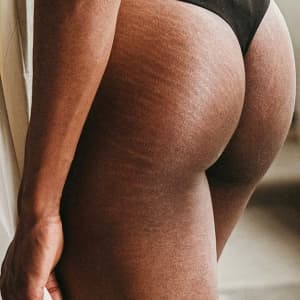 Butt Lift
Butt LiftThe Popular BBL Is Getting A Major Makeover
When bigger isn’t always better.
The idea of a perfectly round, smooth, and sculpted backside has propelled significant demand for the Brazilian butt lift (BBL). Despite the fact that the infamous procedure has had its time in the spotlight for a myriad of reasons — celebrities who embrace the bigger-is-better booty push the surgery to the top of many women's surgery wishlists, while the dangerous links to embolisms and even death make the BBL front-page chatter — its popularity has hardly waned. New and improved versions, as well as plenty of safety regulations, keep the butt-boosting surgery in the public eye.
Aesthetic trends and beauty ideals are ever-changing. For some, a larger-than-life posterior remains the goal. But that level of curvaceousness isn't on everyone's agenda. If a tweak is more your speed, then you'll be happy to meet the so-called skinny BBL. The traditional BBL isn't going anywhere (it's still a much-requested option for those with enough fat to achieve the voluminous look), but the toned-down skinny BBL is better suited for those with a limited amount of donor fat who are desiring a subtler enhancement.
This time around, it's less about volume and more about contour, says Alexander Earle, MD, a board certified plastic and reconstructive surgeon in Miami. “Typically, the skinny BBL patient wants a curvier look – not an exaggerated one – that from the front has more of an hourglass shape and looks like an upside-down heart from the back," he says. So, who is a candidate for this slimmed down version and how does it differ from the original? We’re breaking down everything you need to know about the skinny BBL.
The BBL Basics
The popular BBL brings to life the notion of taking fat from where it's unwanted and putting it where it is. First, your plastic surgeon performs liposuction to remove unwanted fat from the lower back, waist, stomach, or other areas. Then, the donor fat is purified and transferred to the hips and butt to create a lifted, shapelier buttocks with a dramatic difference between the waist and hips.
In order to achieve this result, a decent amount of fat is needed. As such, “it is not uncommon for traditional BBL patients to be a little overweight by medical standards,” says Zachary Filip, MD, a board certified plastic and reconstructive surgeon in Temecula, CA. This usually means there is enough excess fat for harvesting purposes, especially when a significant increase in volume is the ultimate desire.
The Skinny on the Skinny
A skinny BBL is a modified version of its big sister, the traditional BBL. Its name stems from the lesser amount of fat used and that the procedure accommodates leaner and smaller-framed patients who may not have as much donor fat. The skinny BBL is similar to a traditional BBL in just about every way except for the outcome. It is designed for those who want a more natural, athletic-looking result.
Another key difference between the two BBLs is the amount of fat harvested and injected, says Kevin Tehrani, MD, a board certified plastic and reconstructive surgeon in New York City. Less fat leads to more emphasis on shape rather than size. “Similarly to patients who pick smaller breast implants, those who choose skinny BBL are interested in minor buttock enhancement,” he shares. Rather than completely overhauling the backside and taking it from small and flat to large and voluptuous, the skinny BBL creates more of a ‘booty pop,’ similar to the results of a diligent yet intense workout routine. It also corrects stubborn hip dips.
A standard BBL removes up to 5,000 cubic centimeters (CCs) of fat via liposuction and places 1,000 to 2,000 CCs into each butt cheek. The remaining fat can be used elsewhere, like under the eyes, or discarded. Since there's less fat removal with the modified technique (think 500 to 1,000 CCs), about 500 to 700 CCs or slightly more per cheek is put into the butt to create its new shape. Keep in mind that, in either case, a percentage of this fat will be reabsorbed by the body (more on that below).
Another plus to the skinny BBL is that the added fat addresses hip dips (a.k.a. trochanteric depressions). These indentations or inward-facing curves are hard to correct with exercise and diet. In fact, Dr. Earle says that the more you work out, the worse they can get. One thing to note: this area does not ‘hold’ fat like the buttocks, so there is a chance that the hip dips may return at some point.
Who Is the Skinny BBL Best For?
A skinny BBL makes the BBL a viable option for leaner patients who do not necessarily have stubborn or problem areas of extra fat but want to improve the shape of their butt. “Patients usually weigh in the lower half of ‘normal’ for their height,” Dr. Filip says. Most patients have a BMI of about 20 to 24. In the past, plastic surgeons often rejected these patients for BBLs because they were ‘too skinny’ with too little fat for harvesting purposes. However, the procedure is now safe and effective for lower-BMI patients thanks to improved fat harvesting techniques and cannulas.
So, can someone be too thin for even the skinny version? It is possible (particularly if a patient has a BMI under 20), but plastic surgeons can perform a skinny BBL on thinner patients because the fat removal is from more unconventional areas like the inner knees, arms, calves, and back of the armpits. “We are almost always able to harvest enough fat,” Dr. Tehrani says. “Water-assisted liposuction is a great option since studies show that the technique allows us to harvest more fat compared to other liposuction techniques.” Another benefit? “There is also better take of the fat, so more of it survives," he adds.
Besides fat, other options for thinner patients who want to enhance their rear end are biostimulatory Sculptra® injections. The downside is that these injections last two years (at most) and require a lot of product, so it gets expensive quickly. There are also silicone buttock implants, which work well in thinner patients but are less common today due to their high complication rate. “For these reasons, the best option is to gain weight and reach the appropriate BMI before skinny BBL surgery,” Dr. Earle says. Anyone who is medically underweight for any reason will not be cleared to undergo cosmetic surgery (of any kind) until they can maintain a healthy weight.
Skinny BBL Recovery
In terms of recovery, the surgery is considered one of the more difficult procedures to recoup from due to the extent of commitment, protocol, and length. And there's not much difference between the two types of BBLs. “Patients still need to avoid pressure to the buttocks and hips for six weeks, use compression garments for at least three months, and undergo post-liposuction lymphatic massages,” Dr. Earle says. “The biggest difference is that skinny BBL patients require more post-surgery lymphatic massages — about 25 to optimize the results — than the traditional BBL patient.”
In addition, your plastic surgeon may also place a surgical drain to assist in emptying any tumescent solution used during liposuction, says Martin Benjamin, MD, a board certified plastic and reconstructive surgeon in Scottsdale, AZ. And, of course, all patients should maintain a healthy diet and exercise program (when given the all-clear to do so) post-op to keep up their results.
Less Fat Does Not Equal Lesser Results
Just because there's less volume added to the butt during a skinny BBL doesn't mean the results are less striking or short-lived by any stretch of the imagination. Still, there are some nuances to be aware of. According to Dr. Tehrani, the survival rate of a typical fat transfer is about 60 percent. “That means if we inject 1,000 CCs per side, 600 CCs, on average, will survive,” he explains. Fat absorption is one reason why plastic surgeons prefer to over-inject fat. “However, this approach is not always an option for skinny patients, as they may not have enough fat for overcorrection,” he says. “So, we use ACell MicroMatrix®, which contains stem cells that have special growth factors that improve fat survival by 20 to 30 percent.”
Regardless of how much fat your plastic surgeon transfers, the outcome should ultimately be permanent. As Dr. Filip shares, “once a patient heals, the results should be stable and long-lasting if they maintain a healthy weight.”
More Related Articles
Related Procedures

AI Plastic Surgeon™
powered by'Try on' aesthetic procedures and instantly visualize possible results with The AI Plastic Surgeon, our patented 3D aesthetic simulator.


